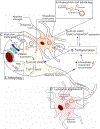LRRK2 links genetic and sporadic Parkinson's disease
- PMID: 30837320
- PMCID: PMC6563926
- DOI: 10.1042/BST20180462
LRRK2 links genetic and sporadic Parkinson's disease
Abstract
The past two decades in research has revealed the importance of leucine-rich repeat kinase 2 (LRRK2) in both monogenic and sporadic forms of Parkinson's disease (PD). In families, mutations in LRRK2 can cause PD with age-dependent but variable penetrance and genome-wide association studies have found variants of the gene that are risk factors for sporadic PD. Functional studies have suggested that the common mechanism that links all disease-associated variants is that they increase LRRK2 kinase activity, albeit in different ways. Here, we will discuss the roles of LRRK2 in areas of inflammation and vesicular trafficking in the context of monogenic and sporadic PD. We will also provide a hypothetical model that links inflammation and vesicular trafficking together in an effort to outline how these pathways might interact and eventually lead to neuronal cell death. We will also highlight the translational potential of LRRK2-specific kinase inhibitors for the treatment of PD.
Keywords: Parkinson's disease; genome-wide association studies; leucine-rich repeat kinase.
© 2019 The Author(s). Published by Portland Press Limited on behalf of the Biochemical Society.
Figures

References
-
- Farrer MJ, Williams LN, Algom AA, Kachergus J, Hulihan MM, Ross OA et al. (2009) Glucosidase-beta variations and Lewy body disorders. Parkinsonism Relat. Disord. 15, 414–416 https://doi.org/10.1016Zj.parkreldis.2008.08.004 - PMC - PubMed
Publication types
MeSH terms
Substances
Grants and funding
LinkOut - more resources
Full Text Sources
Other Literature Sources
Medical
Miscellaneous

